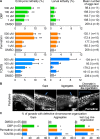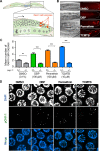Assessing effects of germline exposure to environmental toxicants by high-throughput screening in C. elegans
- PMID: 30763314
- PMCID: PMC6375566
- DOI: 10.1371/journal.pgen.1007975
Assessing effects of germline exposure to environmental toxicants by high-throughput screening in C. elegans
Abstract
Chemicals that are highly prevalent in our environment, such as phthalates and pesticides, have been linked to problems associated with reproductive health. However, rapid assessment of their impact on reproductive health and understanding how they cause such deleterious effects, remain challenging due to their fast-growing numbers and the limitations of various current toxicity assessment model systems. Here, we performed a high-throughput screen in C. elegans to identify chemicals inducing aneuploidy as a result of impaired germline function. We screened 46 chemicals that are widely present in our environment, but for which effects in the germline remain poorly understood. These included pesticides, phthalates, and chemicals used in hydraulic fracturing and crude oil processing. Of the 46 chemicals tested, 41% exhibited levels of aneuploidy higher than those detected for bisphenol A (BPA), an endocrine disruptor shown to affect meiosis, at concentrations correlating well with mammalian reproductive endpoints. We further examined three candidates eliciting aneuploidy: dibutyl phthalate (DBP), a likely endocrine disruptor and frequently used plasticizer, and the pesticides 2-(thiocyanomethylthio) benzothiazole (TCMTB) and permethrin. Exposure to these chemicals resulted in increased embryonic lethality, elevated DNA double-strand break (DSB) formation, activation of p53/CEP-1-dependent germ cell apoptosis, chromosomal abnormalities in oocytes at diakinesis, impaired chromosome segregation during early embryogenesis, and germline-specific alterations in gene expression. This study indicates that this high-throughput screening system is highly reliable for the identification of environmental chemicals inducing aneuploidy, and provides new insights into the impact of exposure to three widely used chemicals on meiosis and germline function.
Conflict of interest statement
The authors have declared that no competing interests exist.
Figures







Similar articles
-
Exposure to benzyl butyl phthalate (BBP) leads to increased double-strand break formation and germline dysfunction in Caenorhabditis elegans.PLoS Genet. 2024 Oct 24;20(10):e1011434. doi: 10.1371/journal.pgen.1011434. eCollection 2024 Oct. PLoS Genet. 2024. PMID: 39446714 Free PMC article.
-
A C. elegans screening platform for the rapid assessment of chemical disruption of germline function.Environ Health Perspect. 2013 Jun;121(6):717-24. doi: 10.1289/ehp.1206301. Epub 2013 Apr 19. Environ Health Perspect. 2013. PMID: 23603051 Free PMC article.
-
Environmentally-relevant exposure to diethylhexyl phthalate (DEHP) alters regulation of double-strand break formation and crossover designation leading to germline dysfunction in Caenorhabditis elegans.PLoS Genet. 2020 Jan 9;16(1):e1008529. doi: 10.1371/journal.pgen.1008529. eCollection 2020 Jan. PLoS Genet. 2020. PMID: 31917788 Free PMC article.
-
Mechanisms and risk of chemically induced aneuploidy in mammalian germ cells.Curr Pharm Des. 2006;12(12):1489-504. doi: 10.2174/138161206776389859. Curr Pharm Des. 2006. PMID: 16611130 Review.
-
Aneuploidy: a report of an ECETOC task force.Mutat Res. 1998 Feb;410(1):3-79. doi: 10.1016/s1383-5742(97)00029-x. Mutat Res. 1998. PMID: 9587424 Review.
Cited by
-
Exposure to benzyl butyl phthalate (BBP) leads to increased double-strand break formation and germline dysfunction in Caenorhabditis elegans.PLoS Genet. 2024 Oct 24;20(10):e1011434. doi: 10.1371/journal.pgen.1011434. eCollection 2024 Oct. PLoS Genet. 2024. PMID: 39446714 Free PMC article.
-
Neonicotinoid-containing insecticide disruption of growth, locomotion, and fertility in Caenorhabditis elegans.PLoS One. 2020 Sep 9;15(9):e0238637. doi: 10.1371/journal.pone.0238637. eCollection 2020. PLoS One. 2020. PMID: 32903270 Free PMC article.
-
The Chemical Exposome of Human Aging.Front Genet. 2020 Nov 23;11:574936. doi: 10.3389/fgene.2020.574936. eCollection 2020. Front Genet. 2020. PMID: 33329714 Free PMC article. Review.
-
Genome-Wide Analysis of Cadmium-Induced, Germline Mutations in a Long-Term Daphnia pulex Mutation-Accumulation Experiment.Environ Health Perspect. 2021 Oct;129(10):107003. doi: 10.1289/EHP8932. Epub 2021 Oct 8. Environ Health Perspect. 2021. PMID: 34623885 Free PMC article.
-
Reproductive-Toxicity-Related Endpoints in C. elegans Are Consistent with Reduced Concern for Dimethylarsinic Acid Exposure Relative to Inorganic Arsenic.J Dev Biol. 2023 Apr 26;11(2):18. doi: 10.3390/jdb11020018. J Dev Biol. 2023. PMID: 37218812 Free PMC article.
References
Publication types
MeSH terms
Substances
Grants and funding
LinkOut - more resources
Full Text Sources
Research Materials
Miscellaneous

